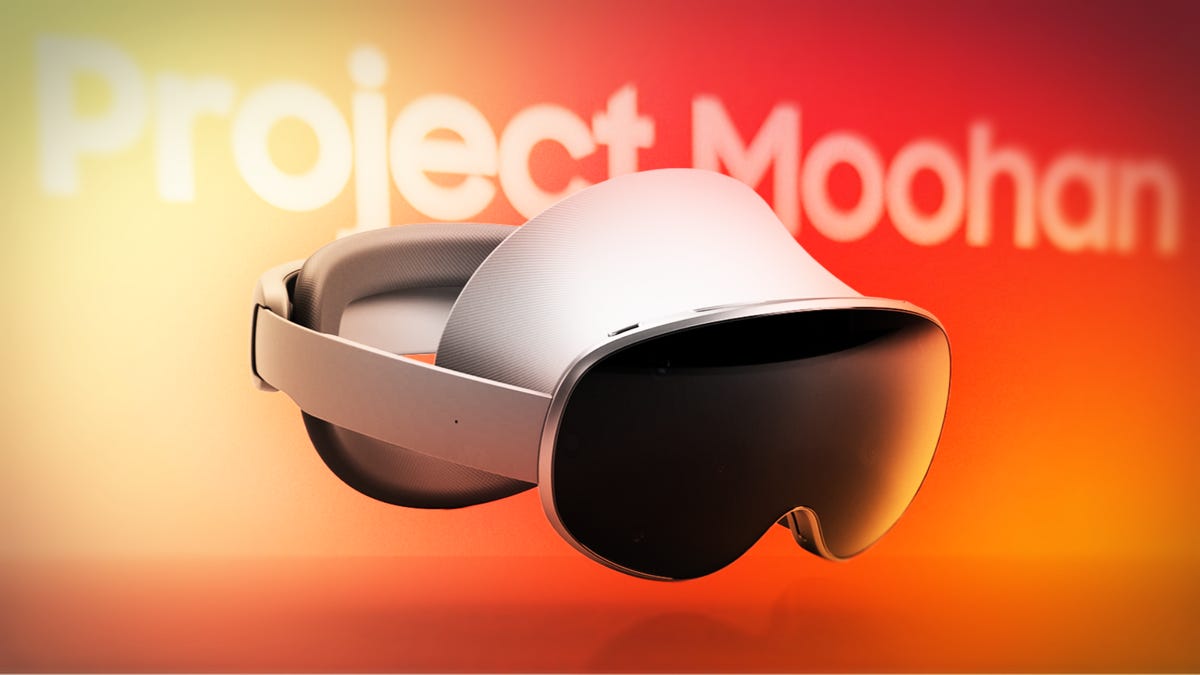Technologies
Samsung’s Project Moohan Headset Has a Secret Weapon. I Got the Lowdown
Google, Qualcomm and Samsung have teamed up on a mixed-reality headset — and one big thing could provide a next-gen experience.

While Meta’s Quest line of headsets has dominated the virtual reality space, mixed reality — using digital displays overlaying the real world — is a new frontier that’s just starting to be explored, going beyond the new Meta Ray-Ban Gen 2 to devices more akin to the Ray-Ban Display glasses. That’s where Google’s Project Moohan MR display aims to make headway. Unlike its prior efforts in the space, like Google Glass, the company hopes to gain an edge by partnering with Qualcomm and Samsung to bolster its chances.
At the Snapdragon Summit 2025 in Maui, I sat down to chat with Sameer Samat, Google’s head of Android, and Alex Katouzian, Qualcomm group general manager of mobile, compute and XR, to check in on Project Moohan and how the broadening of Android and Gemini coalesces with their collaboratively built headset. Which, despite CNET Editor at Large Scott Stein getting hands-on time with an early version of it last December, is still in development.
«We’re super excited about the device coming along really nicely,» Samat said. «We’re definitely getting closer.»
It was clear to Snapdragon Summit attendees that Project Moohan is still in development. The headset was quietly tucked into an easily missed corner of the event, shown off for only a couple of hours under glass and out of anyone’s hands. But Samat was bullish about the progress made in the last year, which has «subtle but very important refinements to the hardware,» he said.
Read more: You Got Your Phone OS in My Laptop! Here’s How Android and ChromeOS Will Merge
Design-wise, Samat explicitly pointed to improvements in the weight balance, ensuring the ergonomics are correct and that the light ingress is where it should be. Where the weight is balanced is crucial in the design of smart glasses that are expected to be worn for hours at a time. When the Apple Vision Pro launched in early 2024, CNET’s Stein noted that the headset felt top-heavy after only half an hour when using the standard single strap. However, using the dual strap was more comfortable, but, in his words, «Looks like the headband on my CPAP machine.» In summary: «A bunch of changes there that I don’t think you see when you look at it, but when you put it on from before and after, I think people would very much notice,» he said.
«I saw early prototypes until now, big difference,» added Katouzian. «I think the weight and the balance is really good and mechanically very well designed.»
Project Moohan uses Qualcomm’s XR2 mixed reality chip. The company worked with Google and Samsung to optimize everything, Katouzian said.
The software has come a long way, Samat continued, and he was quick to affirm that there’s been a lot of refinement in incorporating Gemini into the headset. That loops Project Moohan into the drum Qualcomm and Google were beating throughout Snapdragon Summit 2025: the Gemini experience that uses multiple large language models to answer queries will be an increasingly significant part of using devices, from phones to laptops to headsets, going forward.
«What would happen if, in the user experience, your AI assistant can see and hear what you’re hearing … if they could see the same virtual world as you at the same time, and you could ask them to walk through and explore that world with you?» Samat said. «I’m playing around a lot with that. Even to explore places, like you go somewhere in [Google] Maps and then you walk around and ask questions of Gemini and just explore an entire city with it.»
Bringing contextual information to the screen while going about your day was the dream of older experiments, such as the Google Glass mixed reality glasses released in 2013 and the 2016 Google Daydream, which turned your phone into an augmented reality headset. Samat obliquely referenced these, saying the company has «had our fair share of innovation and being first, but also some things that could have worked better.»
But Samat also pointed to what’s changed in the interim — one of which is computational power from chips like the Qualcomm XR2 that powers Project Moohan. This silicon «opens up another level of fidelity,» he said, pointing to other technical advancements, like optics in the hardware for eye tracking. And AI in general has improved too, with non-Gemini applications that can, for instance, augment Google Photos with uniquely enabled AI experiences in the XR world — experiences that «you’ll see soon enough,» Samat teased.
The companies believe combining Google’s software, Qualcomm’s silicon computational horsepower and Samsung’s ergonomic product design will create something special that fits the mixed reality format better than anything we’ve seen before.
In addition to Project Moohan, Google is exploring a whole range of ideas, including smart glasses. At some point, they’ll take what was developed for its mixed reality headset and shrink it down to something that would more directly compete with Meta’s Ray-Ban Display and others like it. And with Samsung in the mix, there’s a lot of potential.
«The close proximity between the glasses and the phone will bring an advantage that hasn’t been in the market before,» Katouzian said.
Read more: Smart Glasses Are Going to Work This Time, Google’s Android President Tells CNET
If and when a smart glasses collaboration happens, Google has another advantage that might be more appealing than Gemini integration: individual style. Not everyone wants smart glasses from Ray-Ban or Oakley. Google has previously announced that it’s working with Warby Parker and Gentle Monster to presumably put a Project Moohan successor in a variety of frames, which could entice consumers who aren’t fans of wrap-around sports shades.
«The aesthetic of it is super important,» Samat said. «Yes, of course, it’s a piece of technology, but it also has to be something you want to wear.»
Technologies
How to Get Verizon’s New Internet Plan for Just $25 Per Month
Technologies
This $20K Humanoid Robot Promises to Tidy Your Home. But There Are Strings Attached
The new Neo robot from 1X is designed to do chores. It’ll need help from you — and from folks behind the curtain.

It stands 5 feet, 6 inches tall, weighs about as much as a golden retriever and costs near the price of a brand-new budget car.
This is Neo, the humanoid robot. It’s billed as a personal assistant you can talk to and eventually rely on to take care of everyday tasks, such as loading the dishwasher and folding laundry.
Neo doesn’t work cheap. It’ll cost you $20,000. And even then, you’ll still have to train this new home bot, and possibly need a remote assist as well.
If that sounds enticing, preorders are now open (for a mere $200 down). You’ll be signing up as an early adopter for what Neo’s maker, a California-based company called 1X, is calling a «consumer-ready humanoid.» That’s opposed to other humanoids under development from the likes of Tesla and Figure, which are, for the moment at least, more focused on factory environments.
Neo is a whole order of magnitude different from robot vacuums like those from Roomba, Eufy and Ecovacs, and embodies a long-running sci-fi fantasy of robot maids and butlers doing chores and picking up after us. If this is the future, read on for more of what’s in store.
Don’t miss any of our unbiased tech content and lab-based reviews. Add CNET as a preferred Google source.
What the Neo robot can do around the house
The pitch from 1X is that Neo can do all manner of household chores: fold laundry, run a vacuum, tidy shelves, bring in the groceries. It can open doors, climb stairs and even act as a home entertainment system.
Neo appears to move smoothly, with a soft, almost human-like gait, thanks to 1X’s tendon-driven motor system that gives it gentle motion and impressive strength. The company says it can lift up to 154 pounds and carry 55 pounds, but it is quieter than a refrigerator. It’s covered in soft materials and neutral colors, making it look less intimidating than metallic prototypes from other companies.
The company says Neo has a 4-hour runtime. Its hands are IP68-rated, meaning they’re submersible in water. It can connect via Wi-Fi, Bluetooth and 5G. For conversation, it has a built-in LLM, the same sort of AI technology that powers ChatGPT and Gemini.
The primary way to control the Neo robot will be by speaking to it, just as if it were a person in your home.
Still, Neo’s usefulness today depends heavily on how you define useful. The Wall Street Journal’s Joanna Stern got an up-close look at Neo at 1X’s headquarters and found that, at least for now, it’s largely teleoperated, meaning a human often operates it remotely using a virtual-reality headset and controllers.
«I didn’t see Neo do anything autonomously, although the company did share a video of Neo opening a door on its own,» Stern wrote last week.
1X CEO Bernt Børnich told her that Neo will do most things autonomously in 2026, though he also acknowledged that the quality «may lag at first.»
The company’s FAQ says that for any chore request Neo doesn’t know how to accomplish, «you can schedule a 1X Expert to guide it» to help the robot «learn while getting the job done.»
What you need to know about Neo and privacy
Part of what early adopters are signing up for is to let Neo learn from their environment so that future versions can operate more independently.
That learning process raises privacy and trust questions. The robot uses a mix of visual, audio and contextual intelligence — meaning it can see, hear and remember interactions with users throughout their homes.
«If you buy this product, it is because you’re OK with that social contract,» Børnich told the Journal. «It’s less about Neo instantly doing your chores and more about you helping Neo learn to do them safely and effectively.»
Neo’s reliance on human operation behind the scenes prompted a response from John Carmack, a computer industry luminary known for his work with VR systems and the lead programmer of classic video games including Doom and Quake.
«Companies selling the dream of autonomous household humanoid robots today would be better off embracing reality and selling ‘remote operated household help’,» he wrote in a post on the X social network (formerly Twitter) on Monday.
1X says it’s taking steps to protect your privacy: Neo listens only when it recognizes it’s being addressed, and its cameras will blur out humans. You can restrict Neo from entering or viewing specific areas of your home, and the robot will never be teleoperated without owner approval, the company says.
But inviting an AI-equipped humanoid to observe your home life isn’t a small step.
The first units will ship to customers in the US in 2026. There is a $499 monthly subscription alternative to the $20,000 full-purchase price, though that will be available at an unspecified later date. A broader international rollout is promised for 2027.
Neo’s got a long road ahead of it to live up to the expectations set by Rosie the Robot in The Jetsons way back when. But this is no Hanna-Barbera cartoon. What we’re seeing now is a much more tangible harbinger of change.
Technologies
I Wish Nintendo’s New Switch 2 Zelda Game Was an Actual Zelda Game
Hyrule Warriors: Age of Imprisonment has great graphics, a great story and Zelda is actually in it. But the gameplay makes me wish for another true Zelda title instead.

I’ve never been a Hyrule Warriors fan. Keep that in mind when I say that Nintendo’s new Switch 2-exclusive Zelda-universe game has impressed me in several ways, but the gameplay isn’t one of them. Still, this Zelda spinoff has succeeded in showing off the Switch 2’s graphics power. Now can we have a true Switch 2 exclusive Zelda game next?
The upgraded graphics in Tears of the Kingdom and Breath of the Wild has made the Switch 2 a great way to play recent Zelda games, which had stretched the Switch’s capabilities to the limit before. And they’re both well worth revisiting, because they’re engrossing, enchanting, weird, epic wonders. Hyrule Warriors: Age of Imprisonment, another in the Koei-Tecmo developed spinoff series of Zelda-themed games, is a prequel to Tears of the Kingdom. It’s the story of Zelda traveling back in time to ancient Hyrule, and the origins of Ganondorf’s evil. I’m here for that, but a lot of hack and slash battles are in my way.
A handful of hours in, I can say that the production values are wonderful. The voices and characters and worlds feel authentically Zelda. I feel like I’m getting a new chapter in the story I’d already been following. The Switch 2’s graphics show off smooth animation, too, even when battles can span hundreds of enemies.
But the game’s central style, which is endless slashing fights through hordes of enemies, gets boring for me. That’s what Hyrule Warriors is about, but the game so far feels more repetitive than strategic. And I just keep button-mashing to get to the next story chapter. For anyone who’s played Hyrule Warriors: Age of Calamity, expect more of the same, for the most part.
I do like that the big map includes parts in the depths and in the sky, mirroring the tri-level appeal of Tears of the Kingdom. But Age of Calamity isn’t a free-wandering game. Missions open up around the map, each one opening a contained map to battle through. Along the way, you unlock an impressive roster of Hyrule characters you can control.
As a Switch 2 exclusive to tempt Nintendo fans to make the console upgrade, it feels like a half success. I admire the production values, and I want to keep playing just to see where the story goes. But as a purchase, it’s a distant third to Donkey Kong Bananza and Mario Kart World.
Hyrule Warriors fans, you probably know what you’re probably in for, and will likely get this game regardless. Serious Zelda fans, you may enjoy it just for the story elements alone.
As for me? I think I’ll play some more, but I’m already sort of tuning the game out a bit. I want more exploration, more puzzles, more curiosity. This game’s not about that. But it does show me how good a true next-gen Zelda could be on the Switch 2, whenever Nintendo decides to make that happen.
-

 Technologies3 года ago
Technologies3 года agoTech Companies Need to Be Held Accountable for Security, Experts Say
-

 Technologies3 года ago
Technologies3 года agoBest Handheld Game Console in 2023
-

 Technologies3 года ago
Technologies3 года agoTighten Up Your VR Game With the Best Head Straps for Quest 2
-

 Technologies4 года ago
Technologies4 года agoVerum, Wickr and Threema: next generation secured messengers
-

 Technologies4 года ago
Technologies4 года agoBlack Friday 2021: The best deals on TVs, headphones, kitchenware, and more
-

 Technologies4 года ago
Technologies4 года agoGoogle to require vaccinations as Silicon Valley rethinks return-to-office policies
-

 Technologies4 года ago
Technologies4 года agoOlivia Harlan Dekker for Verum Messenger
-

 Technologies4 года ago
Technologies4 года agoiPhone 13 event: How to watch Apple’s big announcement tomorrow
